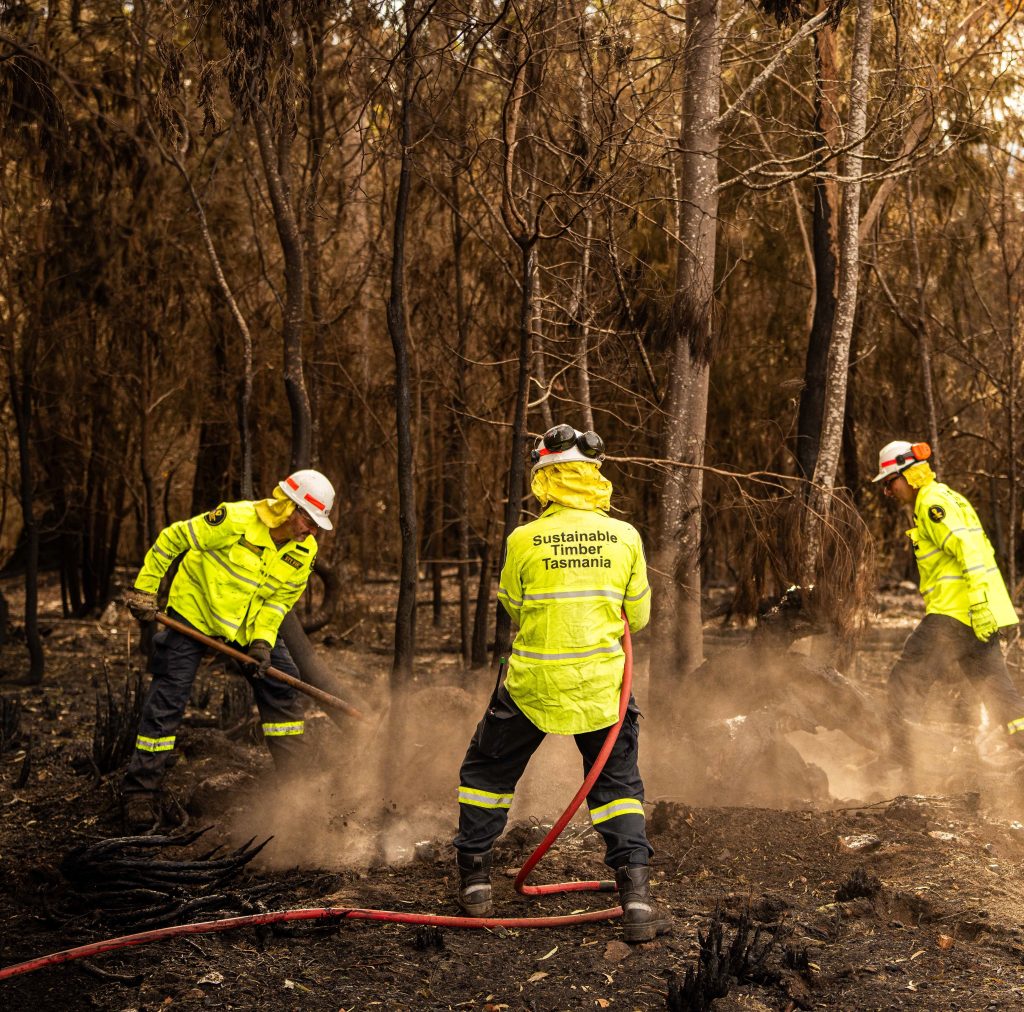How we manage fire
More than 75% of our people are trained firefighters, planners and incident controllers, ready to protect communities and forests.
Every year, we undertake:
- Fuel reduction burns to protect communities and forests; and
- Regeneration burns to regrow harvested forests, in a similar manner to the natural regeneration process that follows a bushfire.
Interagency Bushfire Management Protocol
We are part of Tasmania’s Interagency Bushfire Management Protocol, and work alongside the Tasmania Fire Service and Parks and Wildlife Service to help fight bushfires across all land tenures.
This protocol is unique in Australia and helps us to work together to safely control bushfires across Tasmania.
It ensures that together, we have a clear plan, strong communication, resources, equipment, and machinery to fight bushfires.
Bushfire management principles
We organise our bushfire management around four principles:
- Preparedness – Making sure we are fire ready including, maintenance of fire trails and water storage and consistent training for our staff
- Prevention – Minimising the impact of bushfires through fuel reduction burns and fire detection
- Response – Our reaction to uncontrolled bushfires, including firefighting and investigation
- Recovery –Our commitment to rehabilitating our land
Planned burns
Planned burns are carried out by Sustainable Timber Tasmania to regenerate harvested forests, in a similar manner to the natural regeneration process that follows a bushfire.These burns also help to enhance community safety by reducing fuel loads in Tasmania’s public production forests.
The Program is managed to prioritise safety and minimal impact to neighbours and local communities. Each individual burn is carefully planned for safety, smoke dispersal, protection of assets, infrastructure, special values, and consideration of known local events. These factors are documented, reviewed, and approved along with individual risk assessments.
A planned burn involves strategically lighting and maintaining a fire in an area of harvested forest to regenerate the forest in a similar manner to natural regeneration following a bushfire.
Planned burns are only undertaken when weather conditions are suitable for managing and containing the fire to the prepared boundaries.
Frequently asked questions
Why are planned burns undertaken in autumn?
Autumn is the optimal time for planned burns. The conditions are safer, with lower risk of fire escaping due to cooler temperatures and reduced extreme weather.
It is also the ideal time for eucalypt seedlings to grow because of the warm temperatures and onset of regular rainfall.
How is smoke managed?
Sustainable Timber Tasmania coordinates its Planned Burning Program collaboratively with other agencies and private forestry businesses, with the aim to manage smoke in accordance with the Coordinated Smoke Management System, administered by the Forest Practices Authority.
Smoke from planned burns tends to rise high into the sky. The smoke is usually visible but has minimal impact to local communities as it is not at ground level.
Wherever possible, smoke dispersal is planned away from populated areas. On days when poor smoke dispersal is anticipated, burning is postponed until suitable weather conditions prevail.
How will I know when planned burns are happening?
Before any burns occur, Sustainable Timber Tasmania notifies and engages with immediate neighbours during the planning stage.
Stakeholders who have registered interest in specific burns, including those in the wine and tourism industries, are also informed.
Public advisories are shared with local media and posted to Sustainable Timber Tasmania’s Facebook page twice daily. Additionally, updates and the full Planned Burning Program are available on the “What’s Burning Now?” page at Tasmania Fire Service
How do I find out more information?
We welcome and encourage stakeholders to contact our engagement team at stakeholder@sttas.com.au or on (03) 6169 2800 with questions about the Planned Burning Program.
The Environmental Protection Authority investigates all smoke complaints. This is a Division of the Department of Primary Industries, Parks, Water and Environment. If you would like to make a complaint about smoke, please call 1 800 005 171 or contact the Environment Protection Authority at Air, Smoke and Odour Complaints.

